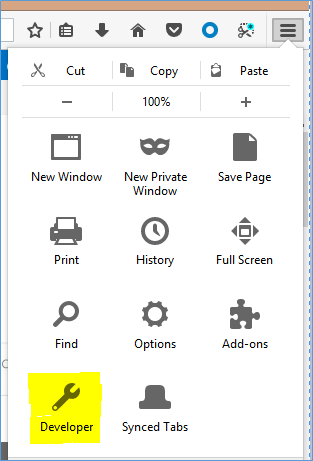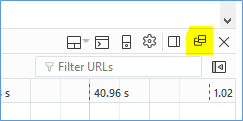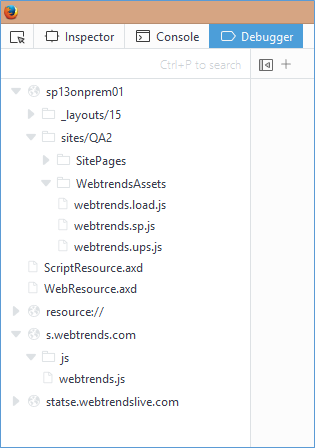Testing in FireFox
-
Open a page that is thought to be tagged with the Webtrends SharePoint Tag, such as the Home page of a site collection.
-
Open the Developer Tools. This can be done by:
a. Pressing F12 on the keyboard.
b. Ctrl + Shift + I on the keyboard.
c. Clicking the 3 horizontal lines in the upper right of the browser and clicking the Developer Tools icon.
 Note:
Note:You can pop the Developer Tools window into its own window by clicking the Show in separate window icon in the upper right.

-
Click on the Debugger tab near the middle of the list of tabs the top.

-
Review the list of Sources in the tab on the left.

-
Verify you see the Webtrends JavaScript files as noted in the Webtrends JavaScript Files section. You may need to locate these files in sub folders.
a. If tagged using the App, the files normally appear in the /WebtrendsAssets/ folder under the root site collection path.
b. These files may appear from a folder under another site collection if using the App-Extension, for SPO Modern View.
b. If tagged using the WSP method, the files normally appear in the /_layouts/15/WebtrendsAssets/ folder.
c. If tagged using the manual method, please review the window.wt_sp_globals.url setting in the webtrends.load.js file to verify the specific location.
d. If the webtrends.js is being loaded from the hosted site, you will find this in its own section under s.webtrends.com > js. -
Click on the **Network **tab near the right side of the list of tabs the top.

-
Refresh the page or press **F5 **on the keyboard.
-
Use the Filter box in the upper right and search for the domain of your SDC server (eg sdc.yourdomain.com).
 Note:
Note:If you see a row with sdc.yourdomain.com and wtid.js in the URL, but do not see a row with dcs.gif, you may have the DCSID value set incorrectly. This causes the SDC server to reject the request, and the tag will not continue.
-
Click on the dcs.gif row that appears in the list.
-
Click on the Params tab in the right panel that appears.
 Note:
Note:We have seen that the dcsqry parameter will sometimes appear truncated within the FireFox Params screen, making it appear that some data may be lost.
This is purely cosmetic. Right clicking the dcs.gif row and copy/pasting the URL into a text editor reveals that the dcsqry parameter is not actually truncated.
-
Review the data in the hit by looking at each parameter and value and determining if the expected values are appearing.
-
To verify link tracking, click the Clear (garbage can) icon to remove all previously found entries.

-
Return to the browser window.
-
Find a link you wish to test.
a. If Collect all links clicks? (app method), or the allClick option in the webtrends.load.js file (manual or WSP method) are true, clicks to any <a> link on the page should trigger a hit.
b. If these options are not enabled, only some links will be expected to pass data. Navigate to a document library and use adocument link orHover Card orRibbon link to test. -
Left click on the desired link, but do not let go of the mouse button. Drag the mouse slightly. Then** let go** of the mouse button.
a. This will cause the link click hit to be sent, but the browser will not move to the next page. This allows you to review the data while still staying on the same page. Multiple links can be quickly tested using this technique.Note:There is also a “Enable persistent logs” checkbox in the Toolbox Options (gear icon) that will keep or discard all the traffic when moving to another page.
Turn it on, so that if you fully click on a link and move to the next page the link click hit will not be lost in the process and should appear as the next line in the list.


-
Review the data in the link click hit by repeating the last few steps.